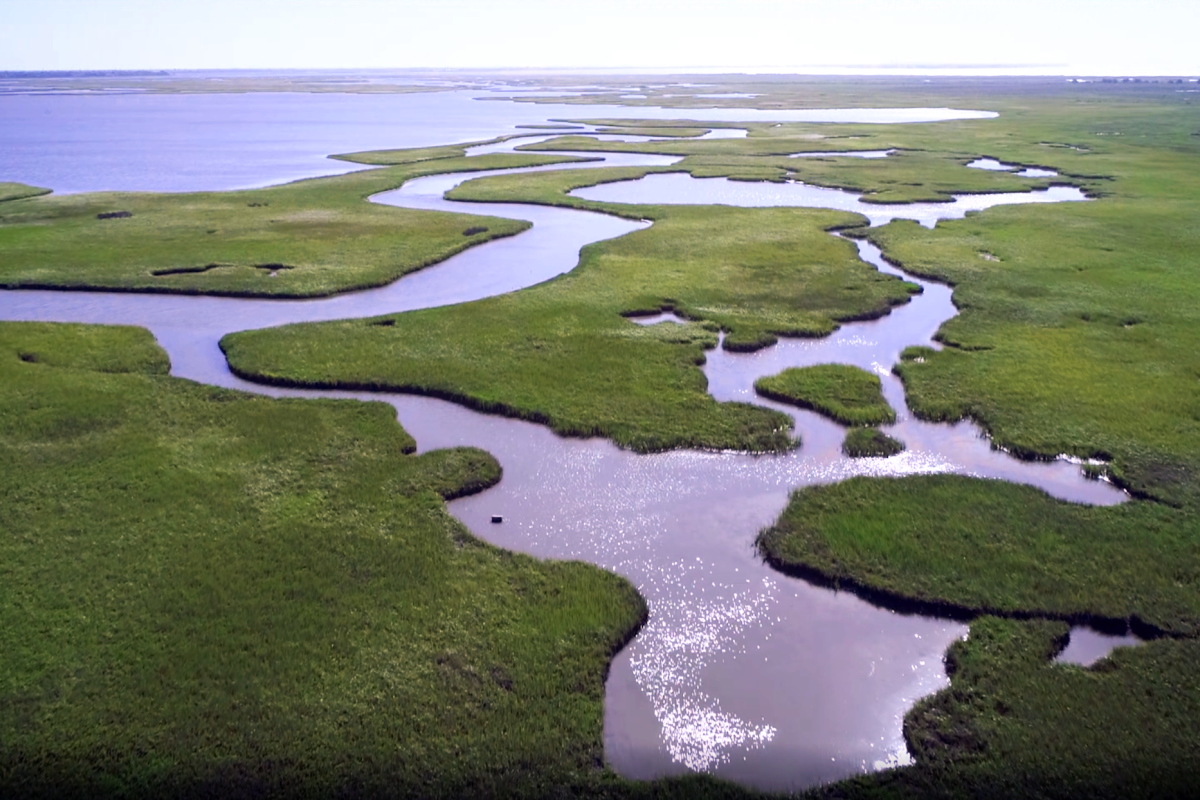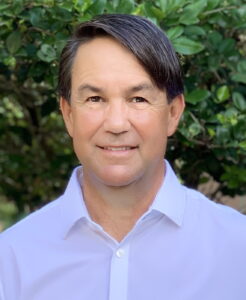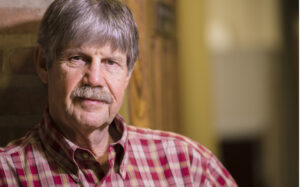
Protection of this marshland near Galveston Bay is supported by carbon sequestration credits from the nonprofit Texas Coastal Exchange. Photo courtesy Kirksey Architecture
This story is part of Covering Climate Now, a global journalism collaboration strengthening coverage of the climate story.
For four generations, the combined Broussard and Hebert families have owned land in the Beaumont area of Southeast Texas that includes rice fields, coastal prairie and marshland. With a grant from the Texas Coastal Exchange funded by San Antonio-based Valero Energy, the family plans to capture 10,000 tons of carbon dioxide on 4,000 acres of it.
“The grant is something we hope will allow us to increase the cash flow from our properties and actually enhance them and make them more productive,” Jimmy Broussard said.

Jimmy Broussard Photo courtesy Jimmy Broussard
“We’re real interested in preserving our land, but it costs money to own it. Anytime you can increase cash flow to landowners, they can do a better job of taking care of their property. We’ve owned these lands for many years, but they have a very low return compared to their value if we decided to break up and sell them.”
The nonprofit Texas Coastal Exchange, or TCX, provides a way to compensate landowners for protecting and restoring natural ecosystems, which can remove carbon dioxide from the air, reduce severity of flooding and storm surges, nurture fisheries and provide migratory bird habitat.
Co-founder Jim Blackburn, an environmental law professor at Houston’s Rice University, said it was inspired by research at the university’s SSPEED Center (Severe Storm Prediction, Education and Evacuation from Disaster). Hurricane Ike in 2008 brought devastation to a long stretch of the Texas coastline, including widespread flooding in the island city of Galveston. But aerial flyovers and computer modeling after the storm showed that areas of coastal plain stored vast quantities of storm surge water that then poured back into the Gulf of Mexico without causing any significant damage. The exchange concept offers a way to create more storage for surge water and generate income for landowners.
“It would be nice to set aside a large, undeveloped buffer zone to protect the Texas coast [from storms], but that’s not going to happen with regulation in Texas,” Blackburn said. “Looking for ways to pay land owners for ecological services, it seems there would be a market for carbon sequestration.”
The exchange accepts donations of $20 per ton of stored carbon dioxide from those wanting to offset their carbon footprint (and has tools for calculating individual, household and business footprints on its website). Participating landowners receive $17 per ton and $3 goes to administration.
“The basic premise is that, if we create this market, we will see creative concepts for prairie restoration and cattle grazing that ultimately transform the ecology of the central U.S.,” Blackburn adds.
Soil’s big stabilization potential
Research published in 2017 showed that natural climate solutions – a variety of conservation, restoration and improved land management actions to increase carbon storage or avoid its emission – could provide more than a third of the cost-effective climate mitigation needed between now and 2030 to stabilize warming to below 2 degrees Celsius. Other research suggested that because grasslands are more resilient to drought and wildfire, they make more reliable carbon sinks than forest ecosystems in the face of climate change.
According to a 2020 study led by The Nature Conservancy, soil carbon represents up to 25 percent of the total global potential of natural climate solutions, or 5.5 out of 23.8 gigatons of CO2-equivalent per year. About half of that is considered cost-effective, and a quarter of it low-cost.
Benefits such as increased productivity and soil resilience factor into the equation too. An estimated 40 percent of this potential comes from protecting existing soil carbon reserves and 60 percent of it from rebuilding carbon stocks. Both approaches are important, said co-author Deborah Bossio, a lead scientist at The Nature Conservancy.
Native prairie soils in other regions of the U.S. can sequester 2 to 3 tons of carbon dioxide per acre annually, according to a report from Rice’s Baker Institute. Hard data do not exist for the upper Texas coastal prairie, but those lands may produce similar results.
The report cites other studies showing that grassland soils can store 4.5 tons or more of carbon dioxide per acre per year, while some continuously grazed pastures, by contrast, store less than a ton per acre. Practices such as adaptive multi-paddock, or AMP, grazing can increase that amount. AMP mimics the behavior of native grazers such as bison, intensely grazing a small area for a short time and then giving it a lengthy period to recover. During that recovery, photosynthesis by growing grass pulls nearly four times more carbon dioxide out of the air than the same patch did before it was grazed.
The Baker Institute report concludes that restoring 6 million to 9 million acres of prairie could store the entire annual carbon footprint of Harris County, one of the country’s highest at 18.6 million tons. (Houston is in Harris County, as is a huge industrial complex along the Houston Ship Channel.) The average annual carbon footprint of an individual in the U.S. is 16 metric tons; for an individual in Texas, it is 24.
Blackburn estimates the country’s native grasslands altogether could sequester up to 1 billion metric tons of carbon dioxide each year. The nation’s annual carbon-dioxide output in 2018, according to the Environmental Protection Agency, was less than 7 billion metric tons.
“It comes back to economics”
Tillage, cover cropping, enhanced crop rotations and grazing management all have potential for soil carbon storage, according to the The Nature Conservancy report. One analysis suggests that planting cover crops on 15 percent of the world’s cropland could enable those soils to soak up between 1 and 2 percent of all fossil fuel emissions. Results differ according to soil type, though; cover crops don’t work as well in more arid environments, for example, where they compete for valuable soil moisture. More research is needed to improve estimates of the storage potential of specific methods and local conditions.
But in any environment, leaving the subsurface undisturbed is key. That requires some changes in grazing and management practices, but Broussard thinks landowners are more than willing to change, given the right incentives – meaning cash.
“It comes back to economics,” he said. “Give landowners a pathway to take care of the land and generate cash and it works.”
Because soils have so much carbon in them, small changes can make a big difference, Bossio said. In addition, soil carbon storage can work well with continued food production. “That’s an important thing,” she said. “We want food production systems themselves to be part of solutions to climate problems.”
Yet globally, incentive structures around farming are not conducive to soil carbon storage, and it remains limited in practice to less than 0.0001 percent of the estimated potential. “Any change costs famers something, whether it be cash, labor, attention, or something else,” Bossio said. “We need the systems to support that change.”

Jim Blackburn Photo courtesy Jim Blackburn
Blackburn sees TCX as just such a system. “It takes a property-rights approach, treating carbon storage as a property right,” he said. “If you store it, you have a right to receive payment for it.” In order to work well, the concept requires high enough prices for carbon storage, but Blackburn expects those to rise as demand increases.
While soil carbon storage is more resilient than carbon in aboveground biomass such as forest, which can be cut or burn, it is not necessarily permanent. Nor can carbon be built up in soil indefinitely.
“Sustained effort over time is needed,” Bossio says. “Scientifically, we feel soils that have lost carbon can gain it back to their original levels, and that might be achieved fairly rapidly, within decades. But it is true, we think, that unless you go to great lengths, there will be a saturation level above which it is hard to build more soil carbon. It will level off at some point – that’s a basic biological reality.” Finding ways to push that limit is an active area for research.
But the existing scientific evidence behind soil carbon storage seems promising enough to some to move forward.
Thinking globally, acting locally
Houston’s Kirksey Architecture used Texas Coastal Exchange to offset the firm’s carbon footprint in 2018, 2019 and 2020, supporting lands protected by the Galveston Bay Foundation. The firm previously offset with Carbon Offsets to Alleviate Poverty, or CoTap, which pays farmers to plant native trees and orchards in Nicaragua, Uganda, India, Mexico, Fiji, or Indonesia.
“The fact that this is local meant a lot to us,” said Kirksey sustainability director Colley Hodges. “It helps preserve ecosystem services here in Texas. For a landowner potentially faced with the dilemma of whether to develop a property or conserve it, the exchange is designed to incentivize them to continue to protect those lands. It’s a very Texan solution in a way, a market-based solution, not a top-down regulatory approach. That is really important and why this could be a very successful model.”
TCX does not issue tradable certificates or require testing, basing its award of credits on scientific data for similar properties in the region. “It’s more of an ecologically focused donation and grant program,” Blackburn explains. “Someone makes a donation to get credit, and we make a grant to a landowner. We keep records and the landowner gets documentation.”
Another option under development at the Baker Institute, BCarbon, issues credits that can be commercially traded. Landowners and ranchers determine their own best practices, as long as they do not disturb carbon in the soil for 10 years. This commitment is renewed each year in which a sale takes place. BCarbon requires baseline testing and retesting after three to five years to verify accrual of carbon and has certification requirements to ensure the validity of the carbon storage.
Blackburn predicts that BCarbon transactions will hit millions of tons per year, while TCX likely will be more in the hundreds or thousands of tons. “To the extent there will be a big impact, it will be through BCarbon,” he said. “But individuals gain access through the exchange.”
Another player, Soil Value Exchange, provides investors with soil carbon storage certificates for each ton of carbon dioxide stored in soils via regenerative practices such as AMP. Landowners who join this exchange receive support in transitioning to those practices, free soil carbon measurements and the chance to be paid for soil carbon storage. The organization, which uses BCarbon’s independent verification and certification requirements, sold its first certificates to Shopify in September 2020 and additional ones to Marathon Oil in January 2021.
A need for accountability
Bossio stresses that any program to incentivize soil carbon storage must have the highest level of accountability. “I’m excited by all the innovation, but confused by the plethora of different initiatives. No matter who is paying whom for what, we need to keep an eye on the rigor of the accounting.” A key element of monitoring and verification is field testing.
That assertion is backed by a recent study reporting that 80 percent of projects commercializing carbon capture and sequestration technology have failed. The researchers examined 12 attributes important in determining a project’s success and found credibility of revenues and incentives among the most important.
Such credibility is largely a function of public policy, which is shifting more toward natural climate solutions, including soil carbon storage. The Growing Climate Solutions Act, introduced in July 2020 (H.R.7393 and S. 3894), would have the Department of Agriculture certify the carbon dioxide naturally pulled from the atmosphere by crops and trees. The legislation was the subject of hearings in the Senate Agriculture, Nutrition and Forestry Committee. (No representatives or senators from Texas co-sponsored either version.)
President Joe Biden endorsed the idea early on in his campaign, and mentioned it specifically in his Jan. 27, 2021, Executive Order on Tackling the Climate Crisis at Home and Abroad. A 2021 transition memo from the USDA’s Climate 21 project recommended establishing a Carbon Bank using the existing federal Commodity Credit Corporation to finance climate-smart land management. The bank would buy credits from farmers who employ sustainable agricultural methods, such as planting off-season cover crops, thus helping to move agriculture toward net-zero emissions and creating new income sources for farmers.
The report also notes that existing Farm Bill conservation programs, such as the Conservation Reserve Program, could be used to finance climate-smart practices. Farmers enrolled in that program agree to take environmentally sensitive land out of production and plant species that improve environmental health and quality.
Bossio stresses that while soil carbon storage has a lot of potential, it should be just one of many tools in the tool box for fighting climate disruption.
“We know what to do; let’s just get going,” she said. “But we should never say soil instead of forest, or soil instead of reducing emissions. Soil can especially help in the near term, but that doesn’t mean we don’t have to change our fossil fuel dependence. We don’t intend it to take the place of larger steps or be an excuse for bad behavior. It is not either/or, it is and/and.”
In the case of TCX, that means carbon offset for individuals or businesses and a source of income for landowners. “The exchange is pretty new,” Broussard says. “But so far, the program makes a lot of sense.”
Melissa Gaskill, an independent journalist in Austin, is a contributing editor of Texas Climate News.
